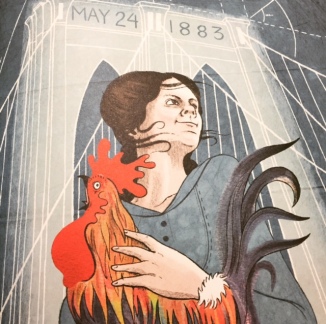
“The name of Mrs. Emily Warren Roebling will thus be inseparably associated with all that is admirable in human nature.”— Congressman Abram S. Hewitt
The Brooklyn Bridge is recognized as one of the most prominent structural feats in the United States. It is noted for its American ingenuity, innovation, and invincibility. However, it is not widely known that a woman, Emily Warren Roebling, was the woman behind the construction of the masterpiece known as the Brooklyn Bridge.
Emily is featured as a forgotten woman in a STEM (science, technology, engineering, and mathematics) field, because without this brave woman, the bridge might have never been completed. She took charge of a daunting project and after its completion, she went to work on equal rights for women in the law field. Emily is one of many silent pioneering women of the United States that advanced STEM fields forever.

Her story begins as any great American love story: she met and fell in love with her husband at a military ball. Colonel Washington Roebling was serving in Virginia in 1864 when the two met and knew it was forever; 11 months later, the two married in 1865. Her marriage into the Roebling family would prove to be a wise decision, as it gave her the means to execute her ideas on the Brooklyn Bridge. Her father-in-law, John Roebling, was the engineer behind the innovative wire suspension cords that changed the face of civil engineering forever. John decided to take on the project of the Brooklyn Bridge, connecting Brooklyn to New York. A few weeks into the project, a freak accident led to John’s death due to tetanus. Washington, Emily’s husband, chose to step in and oversee the project himself — to continue his father’s legacy. As the Roebling’s luck would have it, Washington suffered from the bends while working on the bridge beneath the river’s surface. His sickness became so overwhelming that eventually, he was unable to visit the site to complete the bridge. It seemed as if the project would fail, but Emily stepped in to ensure it’s completion.
Her first move was to convince the president of the New York Bridge Company that her husband was totally fine and could work on the bridge despite his sickness. Amazingly, Murphy agreed to continue the project. Washington remained the Chief Engineer for all intents and purposes, but Emily was the one calling the shots. It must appear to the general public that Emily was merely taking orders from her sick husband. Emily took a crash course in engineering and studied all the notes from the project’s beginning. She played secretary and messenger for 11 years while getting the job done. She relayed her “husband’s demands” while visiting the job site. People commended Emily for her dedication to her husband and his bridge, but little did they know it was really Emily’s bridge.
Amongst cost increases and construction delays and mounting skepticism, it was called for Washington Roebling to be removed as Chief Engineer, but Emily broke boundaries once again. She wrote a detailed statement of all the reasons why her husband should be able to continue the work and presented in front of the American Society of Civil Engineers. She was the first woman to address the group.
Upon the completion of the Brooklyn Bridge, Emily was the first to cross it in its entirety. She chose to carry a rooster with her across the way, some say as a sign of victory or good luck, but I believe it to be a nod to a more anatomy-based suggestion of triumph.

During the dedication ceremony, Congressman Abram S. Hewitt said the Brooklyn Bridge is “an everlasting monument to the self-sacrificing devotion of woman” and today there stands a plaque honoring the Roeblings for their success, John, Washington, and Emily, in completing such a daunting project.
In her final badass moment, she wrote an essay titled “A Wife’s Disabilities”, asking for women to be equal to men before the law. She died at the age of 59 and she is one of the greatest civil engineers in the United States. She didn’t always take the easy path, but she always persevered and came out on top. I believe the Brooklyn Bridge to be a symbol of connecting men and women, a symbol of equality, and a little bit of “anything you can do I can do better.”
Emily Warren Roebling paved the way for many women to get involved in a STEM field and change the face of their community. Providing ideas, resources, and challenges, women have been involved in STEM fields longer than we think. I know when I look at the Brooklyn Bridge I didn’t think a woman had a hand in the construction, but now I know better. Women are ingenious, innovative, and invincible and deserve to be recognized for their efforts in STEM fields.
Have you ever been across the Brooklyn Bridge and seen the plaque? What was it like? Did you know about Emily Warren Roebling before you read this? Comment below and let’s talk!